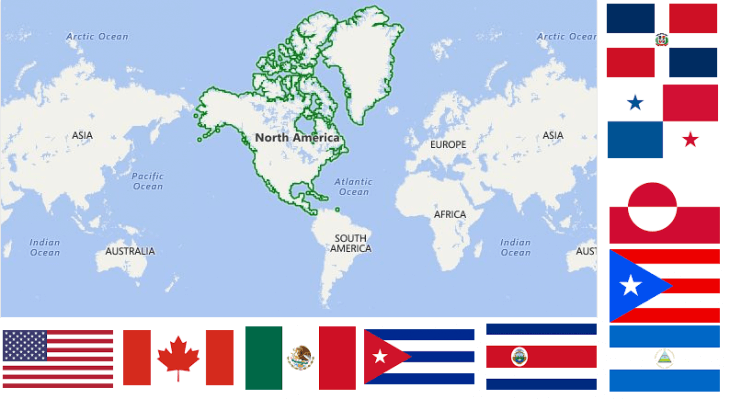As a subcontinent of the Americas, North America is located within Western Hemisphere and Northern Hemisphere. Being the third largest continent after Asia and Africa, the North America continent has an area of 24,709,000 km2, accounting for 16.5% of world’s total land area. With population of 579,024,000, the continent contributes to 7.5% of the world’s population.
How Many Countries in North America
As of 2020, there are a total of 24 countries in North America. Among them, Canada is the largest country by area and United States is the biggest one by population. By contrast, the smallest country in North American continent is Saint Kitts and Nevis, composed by two small islands.
The most common languages are English and Spanish, while many other languages are also spoken, including French, Dutch, and Indian languages. Residents are primarily Protestant or Catholic.
List of All North American Countries
See the following for full list of twenty-four northern American countries in alphabetical order:
| # | Flag | Country | Official Name | Independence Date | Population |
| 1 |  |
Antigua and Barbuda | Antigua and Barbuda | November 1, 1981 | 97,940 |
| 2 |  |
Bahamas | Commonwealth of the Bahamas | July 10, 1973 | 393,255 |
| 3 |  |
Barbados | Barbados | November 30, 1966 | 287,386 |
| 4 |  |
Belize | Belize | September 21, 1981 | 397,639 |
| 5 | Bermuda | Bermuda | – | ||
| 6 |  |
Canada | Canada | July 1, 1867 | 37,742,165 |
| 7 |  |
Costa Rica | Republic of Costa Rica | September 15, 1821 | 5,094,129 |
| 8 |  |
Cuba | Republic of Cuba | January 1, 1959 | 11,326,627 |
| 9 |  |
Dominica | Commonwealth of Dominica | November 3, 1978 | 71,997 |
| 10 |  |
Dominican Republic | Dominican Republic | February 27, 1821 | 10,847,921 |
| 11 |  |
El Salvador | Republic of El Salvador | September 15, 1821 | 6,486,216 |
| 12 |  |
Grenada | Grenada | February 7, 1974 | 112,534 |
| 13 |  |
Guatemala | Republic of Guatemala | September 15, 1821 | 17,915,579 |
| 14 |  |
Haiti | Republic of Haiti | January 1, 1804 | 11,402,539 |
| 15 |  |
Honduras | Republic of Honduras | September 15, 1821 | 9,904,618 |
| 16 |  |
Jamaica | Jamaica | August 6, 1962 | 2,961,178 |
| 17 |  |
Mexico | United Mexican States | September 16, 1810 | 128,932,764 |
| 18 |  |
Nicaragua | Republic of Nicaragua | September 15, 1821 | 6,624,565 |
| 19 |  |
Panama | Republic of Panama | November 28, 1821 | 4,314,778 |
| 20 |  |
St. Kitts and Nevis | Saint Kitts and Nevis | September 19, 1983 | 52,441 |
| 21 |  |
St. Lucia | Saint Lucia | February 22, 1979 | 181,889 |
| 22 |  |
St. Vincent and The Grenadines | Saint Vincent and The Grenadines | October 27, 1979 | 110,951 |
| 23 |  |
Trinidad and Tobago | Republic of Trinidad and Tobago | August 31, 1962 | 1,399,499 |
| 24 |  |
United States | United States of America | July 4, 1776 | 331,002,662 |
Location Map of North America
Biggest Countries in North America and Profiles
Canada
- Capital: Ottawa
- Area: 9,984,670 km²
- Languages: English and French
- Currency: Canadian Dollar
The Canada consists of 10 provinces – Alberta, British Columbia, Manitoba, New Brunswick, Newfoundland and Labrador, Nova Scotia, Ontario, Prince Edward Island, Quebec and Saskatchewan and three territories – the Northwest Territories, Nunavut and Yukon.
United States of America
- Capital: Washington, DC
- Area: 9,831,510 km²
- Language: English
- Currency: US Dollar
The United States has 50 states, which are represented on the existing fifty stars of that nation’s flag.
They are: Alabama, Alaska, Arcansas, Arizona, California, Cansas, North Carolina, South Carolina, Colorado, Conecticute, North Dakota, South Dakota, Delaware, Florida, Georgia, Hawaii, Idaho, Rhodes Island, Illinois , Indiana, Iowa, Kentucky, Louisiana, Maine, Maryland, Massachusetts, Massachusetts, Minnesota, Mississippi, Missouri, Montana, Nebraska, Nevada, New Hampshire, New Jersey, New York, New Mexico, Oklahoma, Ohio, Oregon, Pennsylvania, Tennessee , Texas, Utah, Vermonte, Virginia, West Virginia, Washington, Wiscosin and Wyoming.
Greenland
- Capital: Nuuk
- Area: 2,166,086 km²
- Language: Greenlandic
- Currency: Danish Krone
The Greenland is divided into three counties: West Greenland, Greenland Oridental and northern Greenland.
Mexico
- Capital: Mexico City
- Territorial extension: 1,964,380 km²
- Language: Spanish
- Currency: Mexican Peso
The Mexico is divided into 31 states: Aguascalientes, Baja California, Baja California Sur, Campeche, Chiapas, Chiuaua, Coahuila, Colima, Durango, Guanajuato, Guerrero, Hidalgo, Jalisco, Mexico State, Michoacán de Ocampo, Morelos, Nayarit, New Lion, Oaxaca, Povoa, Arteaga Queretaro, Quintana Roo, San Luis Potosi, Sinaloa, Sonora, Tabasco, Tamaulipas, Tlaxcala, Veracruz, Yucatan and Zaratecas.
